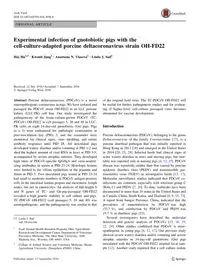
2016 Experimental infection of gnotobiotic pigs with the cell-culture-adapted porcine deltacoronavirus strain OH-FD22 PDF
Preview 2016 Experimental infection of gnotobiotic pigs with the cell-culture-adapted porcine deltacoronavirus strain OH-FD22
ORIGINAL ARTICLE Experimental infection of gnotobiotic pigs with the cell-culture-adapted porcine deltacoronavirus strain OH-FD22 Hui Hu1,2 • Kwonil Jung1 • Anastasia N. Vlasova1 • Linda J. Saif1 Received: 22 July 2016 / Accepted: 7 September 2016 � Springer-Verlag Wien 2016 Abstract Porcine deltacoronavirus (PDCoV) is a novel enteropathogenic coronavirus in pigs. We have isolated and passaged the PDCoV strain OH-FD22 in an LLC porcine kidney (LLC-PK) cell line. Our study investigated the pathogenicity of the tissue-culture-grown PDCoV (TC- PDCoV) OH-FD22 at cell passages 5, 20 and 40 in LLC- PK cells, in eight 14-day-old gnotobiotic (Gn) pigs. Pigs (n = 3) were euthanized for pathologic examination at post-inoculation day (PID) 3, and the remainder were monitored for clinical signs, virus shedding, and serum antibody responses until PID 28. All inoculated pigs developed watery diarrhea and/or vomiting at PID 1-2 and shed the highest amount of viral RNA in feces at PID 3-5, accompanied by severe atrophic enteritis. They developed high titers of PDCoV-specific IgG/IgA and virus-neutral- izing antibodies in serum at PID 23-24. Histologic lesions were limited to the villous epithelium of the jejunum and ileum at PID 3. Two inoculated pigs tested at PID 23-24 had small to moderate numbers of PDCoV antigen-positive cells in the intestinal lamina propria and mesenteric lymph nodes, but not in enterocytes. An analysis of full-length S and N genes of TC- and Gn-pig-passaged OH-FD22 revealed a high genetic stability in cell culture and pigs. TC-PDCoV OH-FD22 (cell passages 5, 20 and 40) was enteropathogenic, and the pathogenicity was similar to that of the original field virus. The TC-PDCoV OH-FD22 will be useful for further pathogenesis studies and for evaluat- ing if higher-level cell-culture passaged virus becomes attenuated for vaccine development. Introduction Porcine deltacoronavirus (PDCoV), belonging to the genus Deltacoronavirus of the family Coronaviridae [27], is a porcine diarrheal pathogen that was initially reported in Hong Kong in 2012 [28] and emerged in the United States in 2014 [20, 25, 28]. Infected herds had clinical signs of acute watery diarrhea in sows and nursing pigs, but mor- tality was reported only in nursing pigs [4, 12, 25]. PDCoV disease was reportedly milder than that caused by porcine epidemic diarrhea virus (PEDV) and transmissible gas- troenteritis virus (TGEV) in seronegative herds [13, 17]. Molecular surveillance studies indicated that PDCoV co- infections are common, especially with rotavirus group C (Rota C) and PEDV [7, 20]. To date, outbreaks have been documented in more than 20 states in the United States and in Canada, China, South Korea, and Thailand [6, 8, 15, 23]. A report from Jiangxi Province, China, indicated that the prevalence of monoinfection by PDCoV was high (33.7 %), and coinfection by PDCoV and PEDV was 19.7 % in diarrheic pigs [23]. Several investigators have described the molecular detection and genetic analysis of PDCoVs [15, 16, 19, 22, 24]. Other studies confirmed that PDCoV is enter- opathogenic in young pigs [4, 12, 17]. Our previous study showed severe watery diarrhea and/or vomiting and severe atrophic enteritis in 14-day-old gnotobiotic (Gn) pigs inoculated with the PDCoV OH-FD22 original fecal sam- ple [12]. Another study reported that a cell culture isolate & Linda J. Saif
